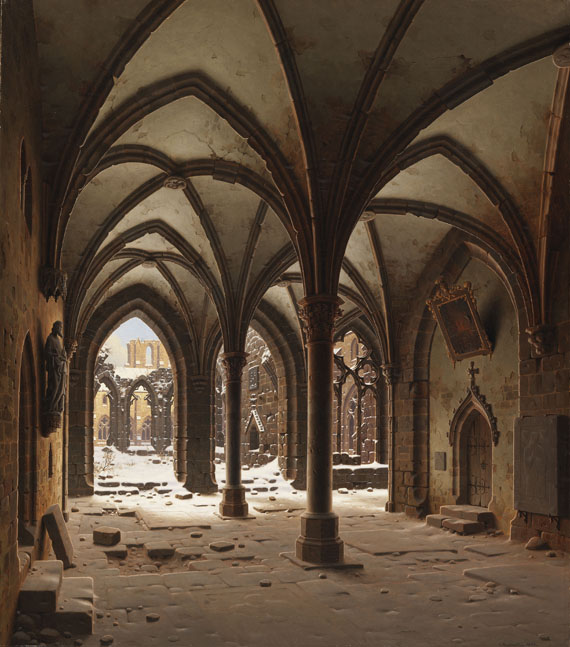646
Carl Georg Adolph Hasenpflug
Die Ruine des Klosters Walkenried im Winter, 1843.
Olio su tela
Stima:
€ 25,000 / $ 29,000 Risultato:
€ 39,040 / $ 45,286 ( commissione inclusa)
Die Ruine des Klosters Walkenried im Winter. 1843.
Oil on canvas.
Signed and dated lower right. 81,5 x 71,5 cm (32 x 28,1 in).
With inscription on verso of stretcher.
PROVENANCE: Private collection England
Private collection Luxemburg.
Born son of a shoemaker in Berlin in 1802, Carl Georg Adolph Hasenpflug first learned his father’s trade. Afterwards he was active in the decoration studio of the Berlin court and theater painter Carl Gropius, and received a scholarship for the Berlin Art Academy from the Prussian king Frederick William III. in 1820. Hasenpflug had his first academy exhibition with a view of the Berlin "Gendarmenmarkts" in 1822. Interrupted by a decoration commission for the theater in Leipzig and a journey to Southern Germany, he studied in Berlin until 1826/27. It was in these days that Hasenpflug also spent time in Magdeburg where he made paintings of the cathedral, he also visited Halberstadt, where he settled in 1828. Fostered by the local capitular, Hasenpflug became soon an established artist with a focus on documental and factual architecture views. He made illustrations of the cathedrals in Brandenburg, Erfurt, Magdeburg and Halberstadt. His view of a complete Cologne cathedral, a work that contains anticipated features, which he made in 1836 id regarded a masterpiece of German architecture painting. After the winter of 1837/38, which brought along more snow than usual, Hasenpflug increasingly made motifs snowed in romantic ruins of monasteries and cloisters. What is so characteristic of these paintings, which would soon be much sought after internationally, is the view through a shady arch on an inner courtyard illuminated in an accentuated light. Up until his death in 1858 the artist remained true to this subject, which earned him great success in numerous exhibitions. Nowadays Hasenpflug‘s paintings have become quite rare on the international art market.
The Cistercian abbey Walkenried on the southern rim of the Harz mountains was founded in 1127. For more than two centuries farming and charcoal production made sure that the monastery was in full swing. Economic crisis and the plague weakened the autonomous society, so that the siege during the Peasants War in 1525 led to the end of life in the monastery. The abbey‘s official closure did not take place before 1648. In the following years the building housed a grammar school or even farmsteads. For 150 years the ruin served as quarry for the surrounding villages. It was not before 1817 that this was stopped and a further demolition was outlawed. Recovery began in the 19\up5 th century, since 2010 the ruin of the monastery Walkenried is UNESCO world cultural heritage. [CB].
Oil on canvas.
Signed and dated lower right. 81,5 x 71,5 cm (32 x 28,1 in).
With inscription on verso of stretcher.
PROVENANCE: Private collection England
Private collection Luxemburg.
Born son of a shoemaker in Berlin in 1802, Carl Georg Adolph Hasenpflug first learned his father’s trade. Afterwards he was active in the decoration studio of the Berlin court and theater painter Carl Gropius, and received a scholarship for the Berlin Art Academy from the Prussian king Frederick William III. in 1820. Hasenpflug had his first academy exhibition with a view of the Berlin "Gendarmenmarkts" in 1822. Interrupted by a decoration commission for the theater in Leipzig and a journey to Southern Germany, he studied in Berlin until 1826/27. It was in these days that Hasenpflug also spent time in Magdeburg where he made paintings of the cathedral, he also visited Halberstadt, where he settled in 1828. Fostered by the local capitular, Hasenpflug became soon an established artist with a focus on documental and factual architecture views. He made illustrations of the cathedrals in Brandenburg, Erfurt, Magdeburg and Halberstadt. His view of a complete Cologne cathedral, a work that contains anticipated features, which he made in 1836 id regarded a masterpiece of German architecture painting. After the winter of 1837/38, which brought along more snow than usual, Hasenpflug increasingly made motifs snowed in romantic ruins of monasteries and cloisters. What is so characteristic of these paintings, which would soon be much sought after internationally, is the view through a shady arch on an inner courtyard illuminated in an accentuated light. Up until his death in 1858 the artist remained true to this subject, which earned him great success in numerous exhibitions. Nowadays Hasenpflug‘s paintings have become quite rare on the international art market.
The Cistercian abbey Walkenried on the southern rim of the Harz mountains was founded in 1127. For more than two centuries farming and charcoal production made sure that the monastery was in full swing. Economic crisis and the plague weakened the autonomous society, so that the siege during the Peasants War in 1525 led to the end of life in the monastery. The abbey‘s official closure did not take place before 1648. In the following years the building housed a grammar school or even farmsteads. For 150 years the ruin served as quarry for the surrounding villages. It was not before 1817 that this was stopped and a further demolition was outlawed. Recovery began in the 19\up5 th century, since 2010 the ruin of the monastery Walkenried is UNESCO world cultural heritage. [CB].
646
Carl Georg Adolph Hasenpflug
Die Ruine des Klosters Walkenried im Winter, 1843.
Olio su tela
Stima:
€ 25,000 / $ 29,000 Risultato:
€ 39,040 / $ 45,286 ( commissione inclusa)




 Lot 646
Lot 646 